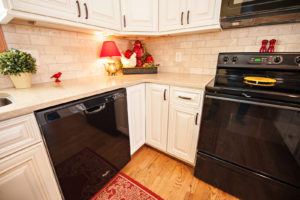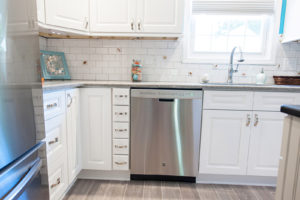This can be quite an interesting article for the ones who are designing a new kitchen or redesigning their old one. Many homeowners wonder about their ideal kitchen setup. They even plan out appliance placements according to their taste and preferences. The basic planning suggested by architects, designers, and kitchen experts is to not keep refrigerators next to stoves and ovens, dishwashers next to refrigerators or stoves, and many more.
Dishwashers often release heat, so dishwasher placements are highly important to ensure safety and accessibility in the kitchen. We hope that this article helps you while you design your kitchen layout and whether you should place a dishwasher next to a stove. Make a list and start planning!
Is it common to have a dishwasher placed next to the oven in kitchen design?
Placing a dishwasher next to the oven is quite common in kitchens where there is limited space, but generally if there are no such space restrictions, homeowners do not place dishwashers right next to the oven. A dishwasher can be installed next to a free-standing, slide-in, or drop-in range of opens. But directly installing the dishwasher next to the oven can be problematic. As long as there are 24 inches of clearance space between the dishwasher and the oven in the kitchen, installing a dishwasher anywhere in your kitchen is safe. The standard of 24 inches must be followed to ensure safety and productivity.
The homeowners must indeed choose the layout of the kitchen design according to their likings. But specific measurements must be kept in mind before planning the appliance placements for their accessibility and your safety. Placing the dishwasher right next to the oven in a kitchen design can become quite frustrating and unproductive. The entire process of cooking and using appliances together gets hampered. Transferring pots, pans, and more oversized utensils become difficult due to heat and lack of space. There must be enough room to access both the oven and the dishwasher properly so that both can be used at the same time. It would be irrelevant if the user is working on one appliance and the other can’t be accessed.

Is it possible to put a dishwasher and stove next to each other?
Speaking of measurements and structures, we have already mentioned that the dishwasher should be at least 24 inches away from the oven. In case you don’t have enough space or casually want to install the dishwasher right next to the stove, you must get a dishwasher with wood panels.
When the dishwasher is kept right next to the oven, it tends to heat the surface a lot. Wood is not a good conductor of heat, so even if the oven heats up the dishwasher, it would not burn or severely hurt you while working close to it.
Is it safe to have a dishwasher next to a stove/oven?
As discussed earlier that the kitchen design is a personal preference. Kitchen Express will happily help you design your kitchen. So, placing the dishwasher right next to the stove would be your call. So, as long as the drainage, electricity, and accessibility are properly done, the dishwasher can be easily installed right next to the stove.
Another thing to keep in mind is that the dishwasher will get heated up if placed next to the oven, but that would not affect its mechanism. It will still clean the dishes like normal. The only thing which may become problematic is that if the surface gets heated up much, you may burn yourself or get hurt by it.
If you have a dishwasher with no outer case and just the inner tub, the dishwasher will get quickly insulated. In this scenario, it is best to place the dishwasher 24 inches or so away from the oven.

Heat from Stove
There can be heating concerns while both the dishwasher and oven are on. Dishwashers also release heat while drying the dishes. And, typically the stove releases 16000 to 17000 Btu, which is quite a lot of heat.
When the dishwasher is placed right next to the oven, it releases more heat than normal, and then the kitchen can become smoky and stuffy. This entire process causes accidents that can burn you. It may become difficult to control the heat when released by both the stove and dishwasher.
It also causes problems while simmering down the heat on the stove, often heating the stove plates. Also, without proper insulation, the distance between the stove and dishwasher should not be less than 5 cm.
Consider Counter Space and Workflow
Another important factor to keep in mind when placing appliances is how the layout affects your workflow. Kitchens function best when there is a logical flow between cooking, cleaning, and food preparation areas. Ideally, your dishwasher should be close to the sink, where dishes are prepped for washing, and your stove should have sufficient counter space nearby for food preparation. This setup makes it easier to move from one task to another efficiently. By keeping these work zones in mind, you can avoid congestion and make daily tasks smoother.
Ventilation and Airflow
Ventilation is another key aspect when placing a dishwasher next to a stove or oven. Both appliances generate heat, and if the kitchen does not have proper ventilation, it can become uncomfortably warm and stuffy. Installing a range hood or proper exhaust system can help reduce the buildup of heat and moisture. It’s also important to ensure that the space between appliances allows for enough airflow to prevent overheating and extend the lifespan of your appliances.
What to Do in Small Kitchens
For smaller kitchens where space is limited, placing a dishwasher next to a stove may be unavoidable. In these cases, it’s essential to use high-quality insulation between the appliances to reduce heat transfer. You can also look for compact dishwashers and stoves designed specifically for tight spaces. These appliances are usually more energy-efficient and better suited for small kitchen layouts, minimizing the risk of overheating or congestion.
Alternative Layout Options

If you’re dealing with a tricky kitchen layout, consider alternative designs like L-shaped or galley kitchens. These layouts often provide more flexibility in appliance placement, ensuring there’s enough room between the stove and dishwasher without sacrificing functionality. In an L-shaped kitchen, you can position the stove on one leg of the “L” and the dishwasher on the other, keeping them separated while maintaining easy access.
Humidity from Dishwasher
Generally, dishwashers release moisture during the drying process. A heating element within the dishwasher creates heat and releases it to dry the dishes quickly.
To prevent the moisture from getting released in the kitchen, dishwashers have a proper outlet system. If this moisture gets released in the kitchen, adding to the heat from the stove, it can cause a lot of accidents.
The dishwashers are covered from the back, which prevents moisture from leaking. But all in all, the humidity from the dishwasher does not cause any harm to the adjacent stove. This article from the New York Times offers some of the best dishwashers available for your kitchen.
Summing-up:
While designing or redesigning your kitchen, you must look after the appliance placements very carefully. So while placing the dishwashers, stoves, ovens, refrigerators, you should keep all of them at the suggested distance. This ensures safety while working in the kitchen. Kitchen Express remodeling experts are happy to help you decide exactly what placement is best for all the appliances in your kitchen – please do not hesitate to contact us for more information about remodeling your kitchen today.
